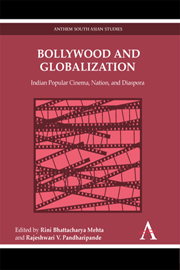Book contents
- Frontmatter
- Contents
- Acknowledgements
- Notes on Contributors
- Chapter One Bollywood, Nation, Globalization: An Incomplete Introduction
- Chapter Two Sentimental Symptoms: The Films of Karan Johar and Bombay Cinema
- Chapter Three Is Everybody Saying ‘Shava Shava’ to Bollywood Bhangra?
- Chapter Four Bollywood Babes: Body and Female Desire in the Bombay Films Since the Nineties and Darr, Mohra and Aitraaz: A Tropic Discourse
- Chapter Five Globalization and the Cultural Imaginary: Constructions of Subjectivity, Freedom & Enjoyment in Popular Indian Cinema
- Chapter Six Rang De Basanti: The Solvent Brown and Other Imperial Colors
- Chapter Seven Between Yaars: The Queering of Dosti in Contemporary Bollywood Films
- Chapter Eight Imagined Subjects: Law, Gender and Citizenship in Indian Cinema
- Chapter Nine ‘It's All About Loving Your Parents’: Liberalization, Hindutva and Bollywood's New Fathers
- Notes
- Select Bibliography
Chapter Six - Rang De Basanti: The Solvent Brown and Other Imperial Colors
Published online by Cambridge University Press: 05 March 2012
- Frontmatter
- Contents
- Acknowledgements
- Notes on Contributors
- Chapter One Bollywood, Nation, Globalization: An Incomplete Introduction
- Chapter Two Sentimental Symptoms: The Films of Karan Johar and Bombay Cinema
- Chapter Three Is Everybody Saying ‘Shava Shava’ to Bollywood Bhangra?
- Chapter Four Bollywood Babes: Body and Female Desire in the Bombay Films Since the Nineties and Darr, Mohra and Aitraaz: A Tropic Discourse
- Chapter Five Globalization and the Cultural Imaginary: Constructions of Subjectivity, Freedom & Enjoyment in Popular Indian Cinema
- Chapter Six Rang De Basanti: The Solvent Brown and Other Imperial Colors
- Chapter Seven Between Yaars: The Queering of Dosti in Contemporary Bollywood Films
- Chapter Eight Imagined Subjects: Law, Gender and Citizenship in Indian Cinema
- Chapter Nine ‘It's All About Loving Your Parents’: Liberalization, Hindutva and Bollywood's New Fathers
- Notes
- Select Bibliography
Summary
A little less than half-way into Rakesh Om Prakash Mehra's Rang de Basanti (Paint it Saffron, 2006), four young men – DJ (Daljit), Karan, Sukhi, and Aslam – are almost accidentally plucked out of their urbane, metropolitan, indeed remarkably privileged Delhi university environment to play the roles of the illustrious revolutionary quartet of Bhagat Singh (1907–1931), Chandrasekhar Azad (1906–1931), Hari Sivaram Rajguru (1908–1931) and Ashfaqullah Khan (1900–1927). As the young students begin to prepare for what is to be an amateur documentary on the lives of these martyrs to the cause of national autonomy, the visual diagram of their own contemporary lives comes into contact with the ‘quaint’ lives and times of Singh, Azad, Khan and Rajguru – boys who were themselves no more than twenty-three or twenty-four when their paths intersected in the most volatile of fashions through the manner in which they chose to die. While Karan, DJ, Sukhi, and Aslam awkwardly grapple with the effort to approximate the roles of men who seem remote from them, in their lives, in their deaths and in their passions, what we view on screen in the first half of Rang de Basanti is the hesitant and stuttering encounter between two distinct visual worlds, estranged from one another by what appears to be an insurmountable chasm.
- Type
- Chapter
- Information
- Bollywood and GlobalizationIndian Popular Cinema, Nation, and Diaspora, pp. 93 - 110Publisher: Anthem PressPrint publication year: 2010
- 1
- Cited by

